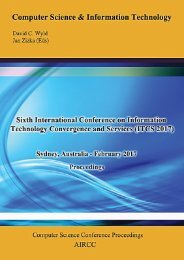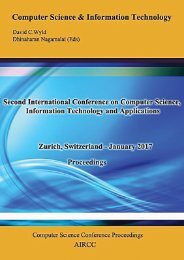CoSIT 2017
Fourth International Conference on Computer Science and Information Technology ( CoSIT 2017 ), Geneva, Switzerland - March 2017
Fourth International Conference on Computer Science and Information Technology ( CoSIT 2017 ), Geneva, Switzerland - March 2017
Create successful ePaper yourself
Turn your PDF publications into a flip-book with our unique Google optimized e-Paper software.
Computer Science & Information Technology (CS & IT) 161<br />
“” tag representing the conformed document type of that particular submission part within<br />
the text version of the filing (10-K, 10-Q, 8-K, EX-1,<br />
EX-2 etc.) [45]. The “Annual Report Algorithm” (RegExes 1-29) uses these requirements in<br />
order to extract the core document and the corresponding exhibits from annual reports while deleting<br />
all documents associated with XBRL and other document (file) types. The search patterns of the<br />
“Annual Report Algorithm” which have been designed accordingly to the filing requirements of the<br />
SEC can be validated due to the general pattern notation of the regular expression language.<br />
An output comparison between the “Annual Report Algorithm” and a common HTML-Parser shall<br />
serve as an additional validation for the remaining extraction procedure. Therefore, I modify the<br />
“Complete Submission Text Files” as provided by the SEC (unadjusted filings) and apply the first part<br />
of the “Annual Report Algorithm” (RegExes 1-29) in order to make the text version of the financial<br />
statements readable for the predefined HTML-Parser (adjusted filings). Since this part of the overall<br />
validation process focuses on how well the “Annual Report Algorithm” is capable of decoding escape<br />
sequences embedded in a “Complete Submission Text File” the aggregated text length of both<br />
procedures are compared rather than the word counts due to decimal character encodings (a simple<br />
word count comparison would not fully capture the disability of the “Annual Report Algorithm” in<br />
decoding these character references in relation to the HTML-Parser). Figure 4 illustrates the output<br />
validation process of the “Annual Report Algorithm”.<br />
Figure 4. Output validation process of the „Annual Report Algorithm”<br />
Notes: The figure presents the output validation process of the “Annual Report Algorithm”. The “Complete<br />
Submission Text File” of each financial statement as provided on the SEC server is adjusted in order to<br />
compare the output of the algorithm with the output a common HTMLParser would produce. RegExes 1-29<br />
modify the unadjusted document as provided on the EDGAR database before applying a predefined text<br />
processing operator (HTML-Parser). The aggregated text length for all filings of both procedures is<br />
compared in order to validate the capability of the „Annual Report Algorithm” in decoding escape<br />
sequences. The aggregated text length includes each individual element in an underlying text document<br />
(text, digits, spaces, special characters etc.).<br />
In contrast to the “Annual Report Algorithm” the modified “Items Algorithm” is validated by its<br />
ability to distribute the extracted information to the individual items an annual report filed with the<br />
SEC is composed of. In order to test and validate the capabilities of the “Items Algorithm” I again use<br />
the “Complete Submission Text Files” as provided by the SEC and extract only the 10-K section of<br />
each filing. For each submission, I retrieve separate word counts for the 10-K section and for all<br />
individual items extracted by the “Items Algorithm”. Despite textual information embedded in the 10-<br />
K section not contained in a particular item (introduction) a word count comparison between the<br />
overall 10-K section and all items represents an attempt to validate the capabilities of the “Items<br />
Algorithm” in extracting certain sections from the core document of an annual report filed with the<br />
SEC and its EDGAR system. Figure 5 illustrates the content validation process of the “Items<br />
Algorithm”.





